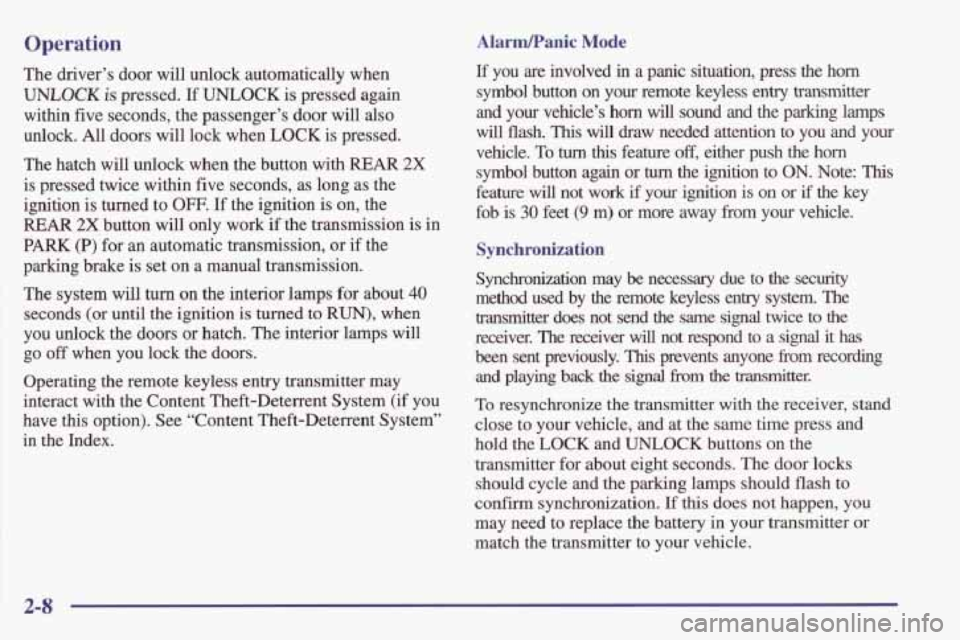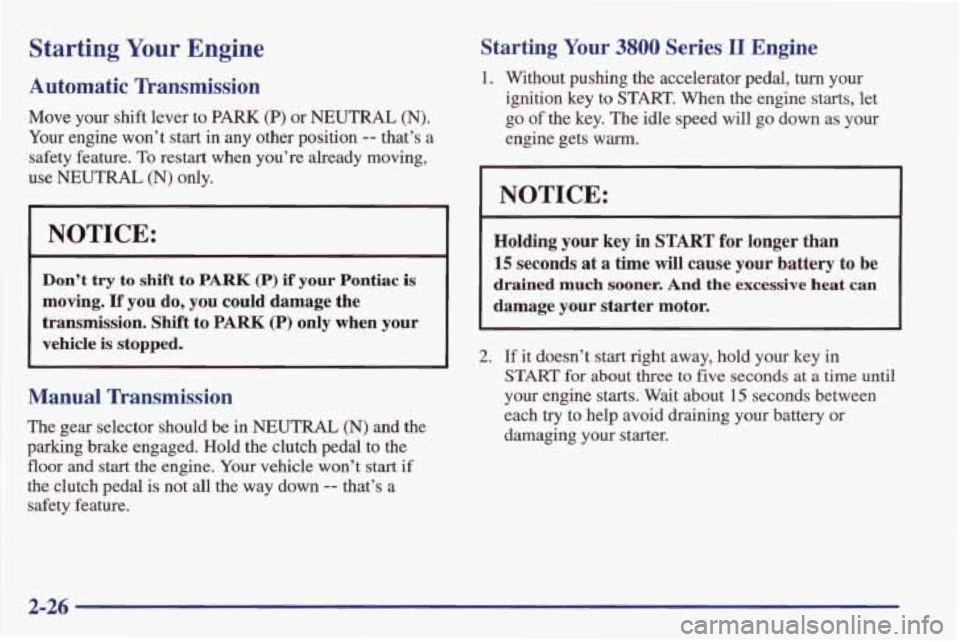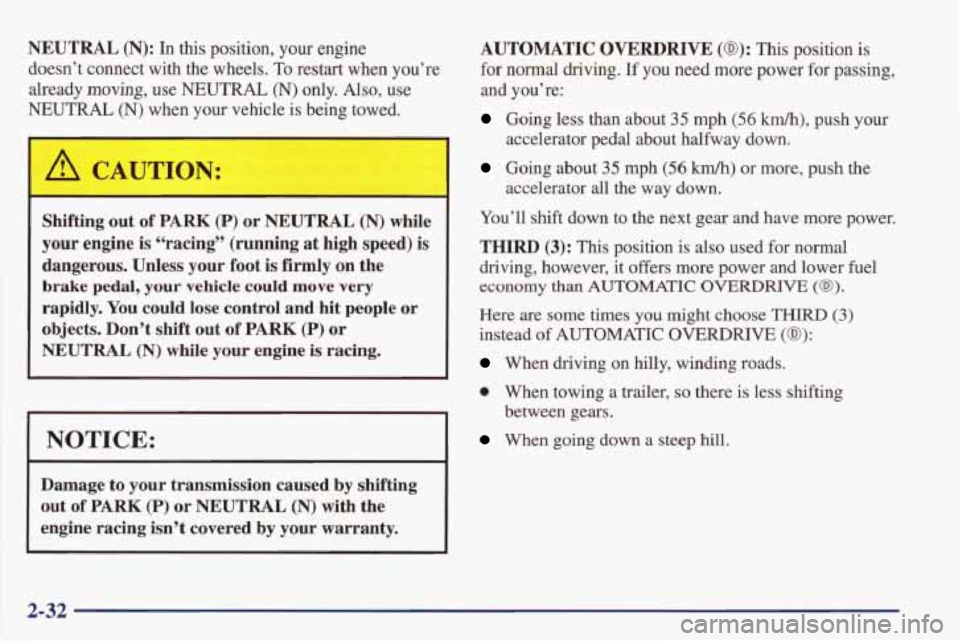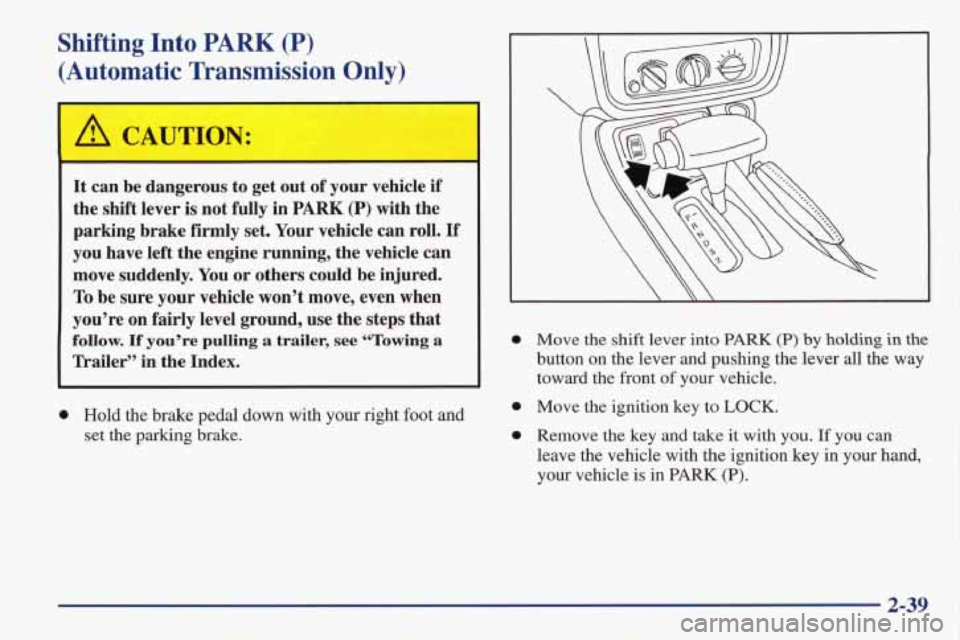automatic transmission PONTIAC FIREBIRD 1998 Owners Manual
[x] Cancel search | Manufacturer: PONTIAC, Model Year: 1998, Model line: FIREBIRD, Model: PONTIAC FIREBIRD 1998Pages: 406, PDF Size: 18.23 MB
Page 56 of 406

Section 2 Features and Controls
Here you can learn about the many standard and optional features on your vehicle, and inform\
ation on starting,
shifting and braking. Also explained are the instrument panel a\
nd the warning systems that tell you if everything
is
working properly -- and what to do if you have a problem.
2-2
2-4
2-6
2-11
2-13
2- 14
2-17
2-18
2-23
2-24
2-26 2-29
2-30
2-35
2-39
2-4 1
Keys
Door Locks
Remote Keyless Entry System
Hatch Theft
Content Theft-Deterrent System
(If Equipped)
PASS-Key@
I1
Feature Customization (If Equipped)
New Vehicle “Break-In”
Ignition Positions Starting Your Engine
Engine Coolant Heater (Canada Only)
Automatic Transmission Operation
Manual Transmission Operation
Shifting Into PARK (P)
(Automatic Transmission Only)
Shifting Out of PARK (P)
(Automatic Transmission)
2-4 1
2-42
2-42
2-43
2-44
2-45
2-46
2-46 2-52
2-55
2-57
2-58
2-62
2-69
2-76
2-79
Parking Your Vehicle (Manual Transmission)
Parking Over Things That Burn
Engine Exhaust
Running Your Engine While You’re Parked
(Automatic Transmission)
Parking Brake
Windows
Tilt Steering Wheel
Turn SignalMultifunction Lever
Exterior Lamps Interior Lamps
Mirrors Storage Compartments
%in Lift-off Roof Panels
(If Equipped)
Convertible
Top
Instrument Panel
Waming Lights, Gages and Indicators
2-1
Page 63 of 406

Operation AlarWanic Mode
The driver’s door will unlock automatically when
UNLOCK is pressed. If UNLOCK is pressed again
within five seconds, the passenger’s door will also
unlock. All doors will lock when LOCK is pressed.
The hatch will unlock when the button with
REAR 2X
is pressed twice within five seconds, as long as the
ignition is turned to
OFF. If the ignition is on, the
REAR 2X button will only work if the transmission is in
PARK (P) for an automatic transmission, or if the
parking brake is set on a manual
transmission.
The system will turn on the interior lamps for about 40
seconds (or until the ignition is turned to RUN), when
you unlock the doors or hatch. The interior lamps will
go off when you lock the doors.
Operating the remote keyless entry transmitter may
interact with the Content Theft-Deterrent System (if you
have
this option). See “Content Theft-Deterrent System”
in the Index.
If you are involved in a panic situation, press the horn
symbol button on your remote keyless entry transmitter
and your vehicle’s
horn will sound and the parking lamps
will flash. This will draw needed attention to you and your
vehicle.
To turn this feature off, either push the horn
symbol button again or turn the ignition to ON. Note: This
feature will not work if your ignition is on or if the key
fob is
30 feet (9 m) or more away from your vehicle.
Synchronization
Synchronization may be necessary due to the security
method used by the remote keyless entry system. The
transmitter does not send the same signal twice to the
receiver. The receiver
will not respond to a signal it has
been sent previously. This prevents anyone from recording
and playing back the signal hm the transmitter.
To resynchronize the transmitter with the receiver, stand
close to your vehicle, and at the same time press and
hold the
LOCK and UNLOCK buttons on the
transmitter for about eight seconds. The door locks
should cycle and the parking lamps should flash to
confirm synchronization. If this does not happen, you
may need to replace the battery
in your transmitter or
match the transmitter to your vehicle.
2-8
Page 67 of 406

Remote Hatch Release
Press the switch under the
main lamp control below
the instrument panel to
unlock the hatch
from
inside your vehicle. The
switch only works when the ignition switch is
in
RUN, ACC or when RAP is present. (See “Retained
Accessory Power” in the Index.)
NOTICE:
If you put things in the hatchback area, be sure
they won’t break the
glass when you close it.
Never
slam the hatch down. You could break the
glass or
damage the defogger grid (if equipped).
If you have an automatic transmission, your shift lever
must be
in PARK (P) or NEUTRAL (N) to use the
switch. If
you have a manual transmission and the
ignition is in RUN, you must set the parking brake
before you can use the switch. On
vehicles with the Content Theft-Deterrent System,
the hatch switch will
not work while the system is
armed. See Tontent Theft-Deterrent System” in
the Index.
2-12
Page 68 of 406

Theft
Vehicle theft is big business, especially in some cities.
Although your vehicle has
a number of theft-deterrent
features, we know that nothing we put
on it can make it
impossible to steal. However, there
are ways you
can help.
Key in the Ignition
If you leave your vehicle with the keys inside, it’s an
easy target for joy riders or professional thieves
-- so
don’t do it.
When you park your vehicle and open the driver’s door,
you’ll hear a chime reminding you to remove your key
from the ignition and take it with you. Always do this.
Your steering wheel will be locked, and so will your
ignition.
If you have an automatic transmission, taking
your key out also locks your transmission. And
remember to lock the doors.
Parking at Night
Park in a lighted spot, close all windows and lock your
vehicle. Remember to keep your valuables out of sight.
Put them in a storage area, or take them with you.
Parking Lots
If you park in a lot where someone will be watching
your vehicle, it’s best to lock it up and take your keys.
But what
if you have to leave your ignition key?
0
0
0
0
0
0
If possible, park in a busy, well lit area.
Put your valuables in a storage area, like your
hatch or glove box.
Be sure to close and lock the
storage area.
Close
all windows.
Lock the glove box.
Lock
all the doors except the driver’s.
Then take the door key and remote keyless entry
transmitter with you.
2-13
Page 79 of 406

Ignition Positions
C
1
A i E
With the ignition key in the ignition, you can turn the
switch to five positions.
ACC (A): Position in which you can operate your
electrical power accessories. Push in the ignition switch
as you turn
it toward you.
LOCK (B): The only position from which you can
remove the key. This locks your steering wheel, ignition
and automatic transmission.
If you have an automatic transmission, the ignition
switch can’t be turned to
LOCK unless the shift lever is
in
PARK (P).
OFF (C): Unlocks the steering wheel, ignition and
automatic transmission, but does not send electrical
power to any accessories. Use this position if your
vehicle must be pushed or towed.
A warning tone will
sound
if you open the driver’s door when the ignition is
off and the key is in the ignition.
RUN (D): Position to which the switch returns after you
start your engine and release the switch. The switch
stays
in RUN when the engine is running. But even
when the engine
is not running, you can use RUN to
operate your electrical power accessories and to display some instrument panel warning and indicator lights.
START (E): Starts the engine. When the engine starts,
release the key. The ignition will return to RUN for
normal driving.
2-24
Page 81 of 406

Starting Your Engine
Automatic Transmission
Move your shift lever to PARK (P) or NEUTRAL (N).
Your engine won’t start in any other position -- that’s a
safety feature. To restart when you’re already moving,
use NEUTRAL (N) only.
NOTICE:
Don’t try to shift to PARK (P) if your Pontiac is
moving. If you do, you could damage the
transmission. Shift to
PARK (P) only when your
vehicle is stopped.
Manual Transmission
The gear selector should be in NEUTRAL (N) and the
parking brake engaged. Hold the clutch pedal to the
floor and
start the engine. Your vehicle won’t start if
the clutch pedal
is not all the way down -- that’s a
safety feature.
Starting Your 3800 Series I1 Engine
1. Without pushing the accelerator pedal, turn your
ignition key to
START. When the engine starts, let
go
of the key. The idle speed will go down as your
engine gets warm.
I NOTICE:
~~
Holding your key in START for longer than
15 seconds at a time will cause your battery to be
drained much sooner. And the excessive heat can
damage your starter motor.
2. If it doesn’t start right away, hold your key in
START for about three to five seconds at a time until
your engine starts. Wait about 15 seconds between
each
try to help avoid draining your battery or
damaging your starter.
Page 85 of 406

4. Before starting the engine, be sure to unplug and store
the cord
as it was before to keep it away from moving
engine
parts. If you don’t, it could be damaged.
How long should you keep the coolant heater plugged
in? The answer depends on
the outside temperature, the
kind of oil you have, and some other things. Instead of
trying to list everything here, we ask that you contact
your dealer in the area where you’ll be parking your
vehicle.
The dealer can give you the best advice for that
particular area.
Automatic Transmission Operation
There are several different positions for your shift lever.
PARK (P): This locks your rear wheels. It’s the best
position to use when
you start your engine because your
vehicle can’t move easily.
2-30
Page 87 of 406

NEUTRAL (N): In this position, your engine
doesn’t connect with the wheels.
To restart when you’re
already
moving, use NEUTRAL (N) only. Also, use
NEUTRAL (N) when your vehicle is being towed.
Shifting out
of PARK (P) or NEUTRAL (N) while
your engine is “racing” (running
at high speed) is
dangerous. Unless your foot
is firmly on the
brake pedal, your vehicle could move very
rapidly. You could lose control and hit people or
objects. Don’t shift out
of PARK (P) or
NEUTRAL (N) while your engine is racing.
NOTICE:
Damage to your transmission caused by shifting
out
of PARK (P) or NEUTRAL (N) with the
engine racing isn’t covered by
your warranty.
I
AUTOMATIC OVERDRIVE (03): This position is
for normal driving. If you need more power for passing,
and you’re:
Going less than about 35 mph (56 km/h), push your
Going about 35 mph (56 km/h) or more, push the
You’ll shift down to the next gear and have more power.
THIRD (3): This position is also used for normal
driving, however, it offers more power and lower fuel
economy
than AUTOMATIC OVERDRIVE (a).
Here are some times you might choose THIRD (3)
instead of AUTOMATIC OVERDRIVE (a):
When driving on hilly, winding roads.
0 When towing a trailer, so there is less shifting
When going down a steep hill.
accelerator pedal about halfway down.
accelerator
all the way
down.
between gears.
2-32
Page 88 of 406

SECOND (2): This position gives you more power but
lower fuel economy. You can use
SECOND (2) on hills.
It can help control your speed as you
go down steep
mountain roads, but then you would also want to use
your brakes off and on.
NOTICE:
Don’t drive in SECOND (2) for more than
25 miles (40 km), or at speeds over 55 mph
(88 km/h), or you can damage your transmission.
Use AUTOMATIC OVERDRIVE
(a) or
THIRD (3) as much as possible.
Don’t shift into
SECOND (2) unless you are going
slower than
65 mph (105 kmh), or you can
damage your engine. FIRST
(1): This
position (if equipped) gives you
even more power (but lower fuel economy) than
SECOND (2). You can use it on very steep hills, or in
deep snow
or mud. If the gear shift lever is put in first
gear, the transmission won’t shift into
FIRST (1) until
the vehicle is going slowly enough.
NOTICE:
If your rear wheels can’t rotate, don’t try to
drive. This might happen if you were stuck in
very deep sand or mud
or were up against a solid
object. You could damage your transmission.
Also, if you stop when going uphill, don’t hold
your vehicle there with only the accelerator
pedal. This could overheat and damage the
transmission. Use your brakes or shift into
PARK (P) to hold your vehicle in position
on a hill.
Maximum engine speed is limited to protect driveline
components
from improper operation.
2-33
Page 94 of 406

Shifting Into PARK (P)
:Automatic Transmission Only)
A CAUTION:
It can be dangerous to get out of your vehicle if
the shift lever is not fully in
PARK (P) with the
parking brake firmly set. Your vehicle can roll.
If
you have left the engine running, the vehicle can
move suddenly. You or others could be injured.
To be sure your vehicle won’t move, even when
you’re on fairly level ground, use the steps that
follow. If you’re pulling a trailer, see “Towing a
Trailer” in the Index.
0 Hold the brake pedal down with your right foot and
set the
parking brake.
0 Move the shift lever into PARK (P) by holding in the
button on the lever and pushing the lever all the way
toward the front of your vehicle.
0 Move the ignition key to LOCK.
0 Remove the key and take it with you. If you can
leave the vehicle with the ignition key in your hand,
your vehicle
is in PARK (P).
2-39